Posts: 307
Threads: 22
Likes Received: 531 in 232 posts
Likes Given: 117
Joined: Oct 2023
The wireless control side of things is progressing well.
In a prototype format the system is running with frequency hopping for suppressing signal fade and the throttles using time division multiplexing to communicate with the Wireless Hub which then onward broadcasts a single multi-car packet that all cars receive.
The throttles are currently using an ATmega328u/nRF24 combination.
The Wireless Hub is currently using the same above configuration though in due course this will be upgraded to an
nRF52840 module as per the photograph below. The small co-axial socket on the module is for attachment of a back-of-box vertical oriented 2.4GHz antenna to ensure maximum range.
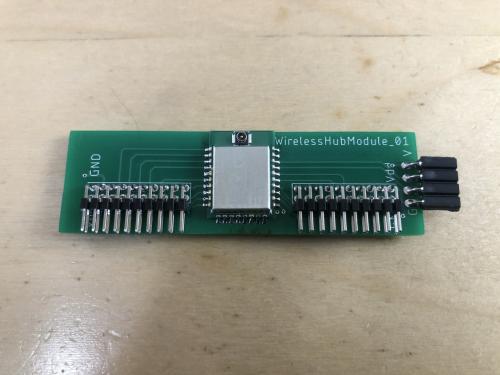
The in-car decoders as shown earlier in this thread use the ATmega328u/nRF24 combination with a more advanced version using the nRF52832. The latter has been designed in ‘saloon’ DPR-size and F1-size. Both include control of lighting circuits.
I appreciate this is, maybe, a bit too technical for some readers (and perhaps not enough for others)… anyway I hope it was worth the read.
This is a new digital slot car system in development.
c
(This post was last modified: 16th-Apr-24, 05:08 PM by
Dr_C.)
Posts: 307
Threads: 22
Likes Received: 531 in 232 posts
Likes Given: 117
Joined: Oct 2023
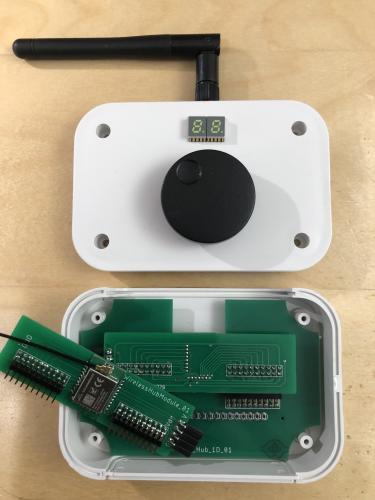
Here is the work-in-progress ‘Wireless Hub’ for 12 car control.
The dial and LED readout are for channel selection and ID binding. All 12 cars use the same channel set once selected so this only needs to be done once. ID binding is carried out individually for the 12 wireless throttles and the 12 in-car decoders. In each case the desired ID is selected in the range 1-12 using the dial and a press-to-select feature.
For lap counting and lane change, this is achieved using an extension of the SSD Infra-red strobe technique in conjunction with under track phototransistors and a sensor hub module.
IDs 1-6 match the standard SSD mark-to-space protocol and these, if required can register laps with the APB and ARC Pro powerbases as an alternative to the above mentioned sensor hub. All 12 IDs control standard SSD lane-changers (this has been reported earlier with a technical limitbof 14 cars).
The wireless hub (as can be seen in this photo) is in development at present with some way to go before the device is ready for testing on a 12 car raceway. Prototype wireless hubs (not quite as smart looking) are already running and the throttle-to-hub-to-car link has already been tested with the in-car decoder in a car running on a test track. So progress is happening.
c
(This post was last modified: 20th-Apr-24, 11:41 AM by
Dr_C.)
![[+]](https://slotracer.online/community/images/bootbb/collapse_collapsed.png) 1 member Likes Dr_C's post:1 member Likes Dr_C's post
• LMP
1 member Likes Dr_C's post:1 member Likes Dr_C's post
• LMP
Posts: 307
Threads: 22
Likes Received: 531 in 232 posts
Likes Given: 117
Joined: Oct 2023
Earlier I showed a 2x20pin RF module which is based on the Nordic nFR52840 wireless chip. This module forms the core of a twelve car wireless hub which is designed to receive inputs from up to twelve wireless throttles. The wireless hub then either forwards this throttle data unmodified onwards to the twelve cars or, alternatively, the data can be modified via input from a race management program running on a PC. This approach is interesting because it should allow both lag-free wireless comms between the throttles and the cars yet at the same time allowing for simulation effects such as fuel mass effects and weather etc. [Note by lag-free I mean approx 10msec maximum delay i.e. undiscernible by human drivers].
It’s early days, the core wireless system functions in terms of reading throttle values and broadcasting this information to the twelve cars. Next to test the PC power control functions via USB signals from the PC (i.e. the race management program).
The image below shows a second prototype of the wireless hub which includes the necessary USB interface. It also includes an interface for a rotary encoder and a two digit LED readout. These are to be used for binding with wireless throttle and also, of course, binding with the wireless in-car decoders.

Still a long way to go … but a truely fun journey from a tech dev point of view.
c
(This post was last modified: 7th-Jun-24, 06:39 PM by
Dr_C.)
Posts: 307
Threads: 22
Likes Received: 531 in 232 posts
Likes Given: 117
Joined: Oct 2023
This project is taking shape nicely.
In it’s initial 12 car format the wireless hub is reading up to twelve throttle IDs using a frequency hopping method (described earlier) with 8bit throttle resolution and fast refresh rates.
The throttle data is then packaged into a single broadcast data packet which all car decoders receive simultaneously. Each car selects the section of the received data which corresponds to their own specific ID.
Where this will get particularly interesting (IMO) is when PC instructions are added into this signal path. I may be mistaken but I don’t believe any of the current in-market wireless digital slot car systems take this approach.
Here the forward plan is that the PC will send additional commands for each ID which may be any of the following:
1/ pass the data from throttle to the broadcast data packet without any modification.
2/ modify the data from the throttles using fast multiplication. Here the raw throttle data would be modified by the PC which would supply a floating point multiplier with value between zero and one. This should be perfect for simulation including fuel loading, tyre wear, weather and damage.
3/ replace the data with PC generated throttle data. This should add the opportunity for multiple pacer cars similar to what can be achieved with APB-style PC controlled pacer cars.
4/ replace the data with a zero throttle value (with or without braking). This would be for power-down before start or pehaps an emergency stop feature for public events.
As I say, this experimentation is starting to get quite interesting :)
c
(This post was last modified: 19th-Jun-24, 10:42 AM by
Dr_C.)
Posts: 307
Threads: 22
Likes Received: 531 in 232 posts
Likes Given: 117
Joined: Oct 2023
It’s fast approaching time to take some video of progress with this project. The wireless hub is correctly receiving throttle signals on IDs 1 through 12 and assembling them into a broadcast packet which is then forwarded wirelessly to the cars on track.
So far I’ve tested six wireless throttles at a time, either IDs 1-6 or IDs 7-12. The process, including frequency hopping, happens 90 times per second i.e. a throttle lag of approximately 11 milliseconds from the driver’s throttle trigger to the car’s motor.
The decoders under test at present are the ones I showed earlier in post #7. Track level testing commenced today with a NSR Mercedes AMG. So far it seems to run smoothly, with strong acceleration, strong braking and lane changing on demand.
The next task is to see how the new system performs with more cars on the track.
And yes, some video to follow soon :)
c
(This post was last modified: 21st-Jun-24, 11:56 PM by
Dr_C.)
Posts: 307
Threads: 22
Likes Received: 531 in 232 posts
Likes Given: 117
Joined: Oct 2023
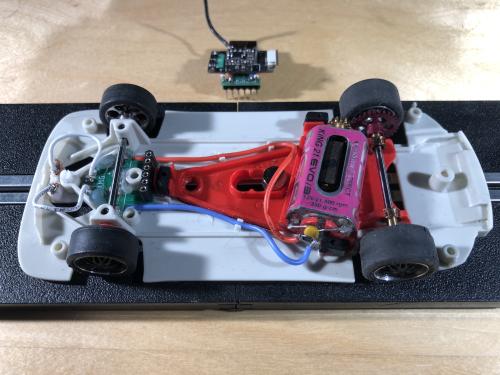
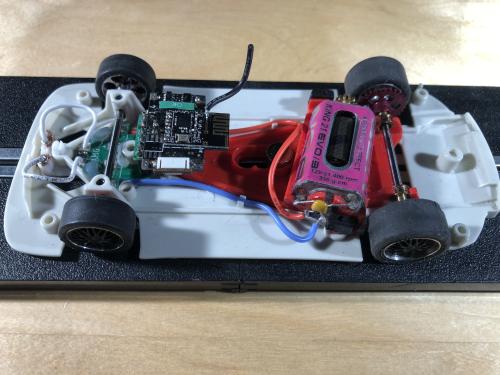
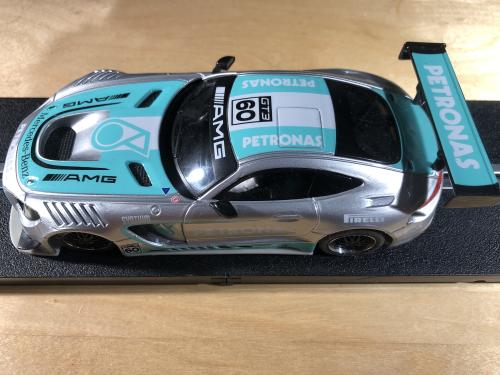
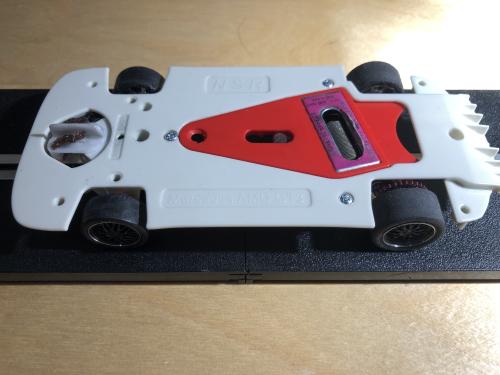
This is my first wireless test car. It’s driven many laps with the new decoder.
Photos taken after a good clean (to remove fluff!).
The front axle is so close to the ‘optimal’ position for the IR LED I had to use a small surface mount version.
The decoder is fitted using a six pin header for easy install and removal - always useful when developing new code :)
c
Posts: 2,367
Threads: 115
Likes Received: 2,549 in 1,353 posts
Likes Given: 6,985
Joined: Jan 2020
Location Eastbourne UK
So...what controller works with this system?
(I smell a purchase opportunity!)
I love puttering with gears
Posts: 307
Threads: 22
Likes Received: 531 in 232 posts
Likes Given: 117
Joined: Oct 2023
Thanks BARacer for the very nice question and comment.
During the early stages of system development we have been using 12 simple development boards with joysticks as throttle controllers.
We are now moving to ARC throttle controllers with modified internal hardware. These are great for initial track level testing of up to 12 cars on track.
But modified ARC throttle controllers themselves have some limits. This is important as the new system offers 8bit throttle resolution, 8bit brake adjustment and head/tail lights on/off - amongst its range of features.
So in answer to your question, yes there is a ‘nice’ spec throttle controller in the development pipeline.
Also, we are looking at a level of system cross-compatibility for these controllers so hopefully, in due course, they will become highly desirable.
c
(This post was last modified: 7th-Jul-24, 01:59 PM by
Dr_C.)
Posts: 34
Threads: 3
Likes Received: 81 in 27 posts
Likes Given: 42
Joined: Nov 2021
Location Solihull, UK
(7th-Jul-24, 11:52 AM)BARacer Wrote: So...what controller works with this system?
(I smell a purchase opportunity!)
Hi Jeremy
Dr_C will be performing some testing at Rockingham SCC on August 24, following a 2hrs race for DiSCA GT4 cars on Oxigen. We are welcoming attendees who are interested to attend and try it for themselves! I know Ed P is thinking of attending so there may be a potential team mate / travel partner. There's a thread on SlotForum if you'd like to register your interest.
Rockingham SCC Digital Saturday and New digital system test Saturday August 24th
Cheers
Gary
Posts: 307
Threads: 22
Likes Received: 531 in 232 posts
Likes Given: 117
Joined: Oct 2023
Thanks Gary.
For anyone interested in what we are planning to test on 24th August, I hope the note below provides some additional clarity:
We plan to bring twelve NSR AMG GT3s with wireless decoders as per the Petronas livery’ed car shown earlier. These cars will strobe their IR LEDs on IDs 1 through 12. They use an extention of the SSD mark-to-space method i.e. extended out from 6 to 12 IDs. Waveform inversion is used to trigger lane changing which is fully compatible with standard SSD XLC electronics. On the 24th August they will be tested with O2 lane changer electronics on Ninco track.
The lap counting method follows the same approach as SSD with under-track phototransistors used to read the Cars’ IDs and then onward reported via USB to a PC running PC Lapcounter. This method has been proven to function on IDs 1 through 36 though PC Lapcounter itself is currently limited to 32 cars (which is more than plenty).
The cars are controlled by wireless throttles. Here we will bring a 12 car ‘cruise control’ panel which, effectively, is 12 separate wireless throttle controllers each with a rotary speed dial and all built onto a single panel. It’s a simple way to get 12 test cars running side-by-side. Next we can move onto twelve individual throttle controllers based on the ARC PRO throttle enclosures but with upgraded electronics. Here is where the skills of the drivers from the earlier GT4 event will come into play, please.
If all goes well we will then unpack some rather special newly designed controllers ;)
We already know that lap detection functions reliably. So the focus on 24th August will be around the wireless side of things. Here the approach is slightly different from existing in-market solutions. We are using multichannel frequency hopping and the signal path is:
Controllers-to-wirelessHub-to-inCarDecoders
i.e ALL wireless signals are routed via the wirelessHub.
This approach enables power level adjustment of the radio signal from the Hub to the cars to ensure adequate range in all circumstances. In the future we anticipate this approach will enable fast over-ride of throttle control signals commanded directly by the PC - this should be ideal for advanced simulations and variable speed pacers etc.
There will be lots of new hardware to test on 24th August, lots of questions to answer, and hopefully lots of fun to be had by all who choose to participate.
Meanwhile, the team behind this new digital system have lots of final preparations to make with just under 6 weeks to go. We are very busy bees!
Thanks for reading this update.
c
(This post was last modified: 14th-Jul-24, 11:30 AM by
Dr_C.)


![[+]](https://slotracer.online/community/images/bootbb/collapse_collapsed.png)